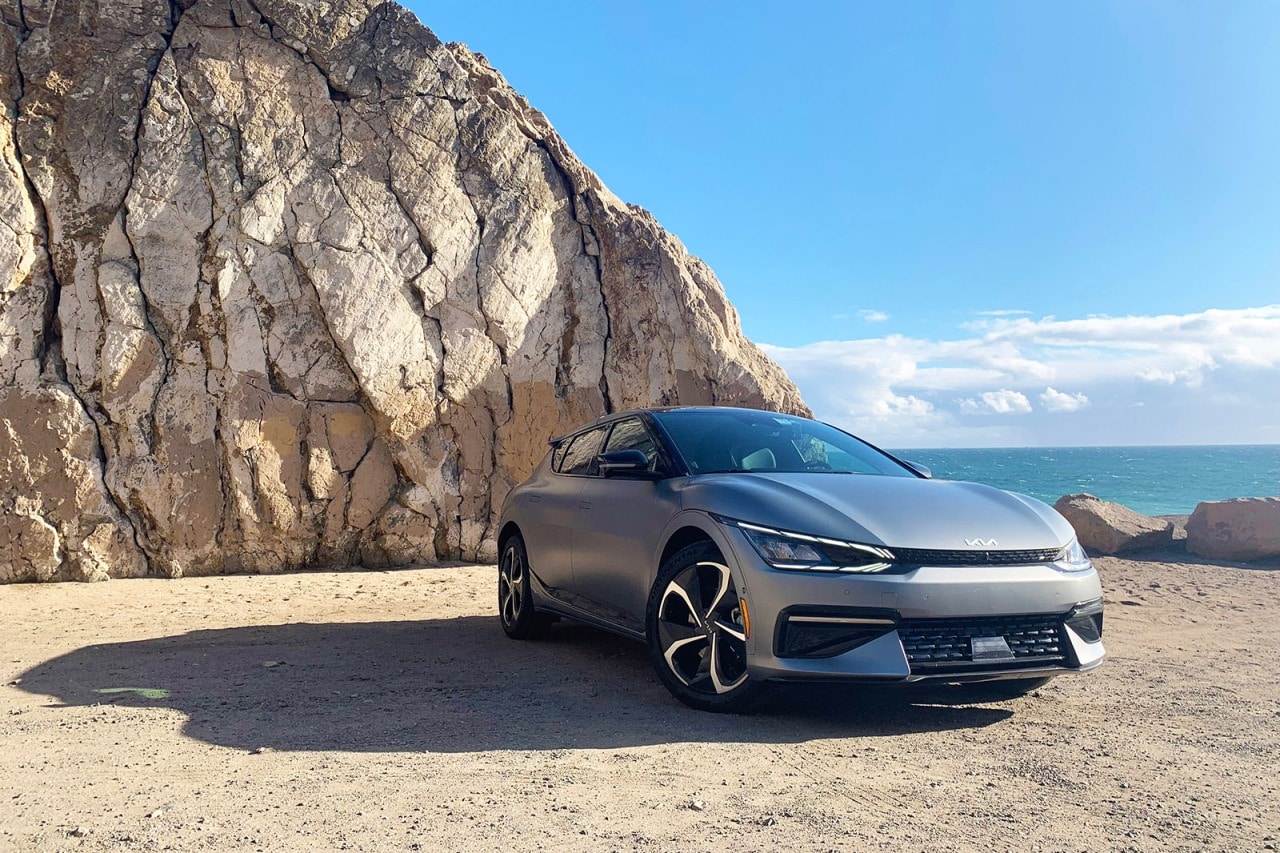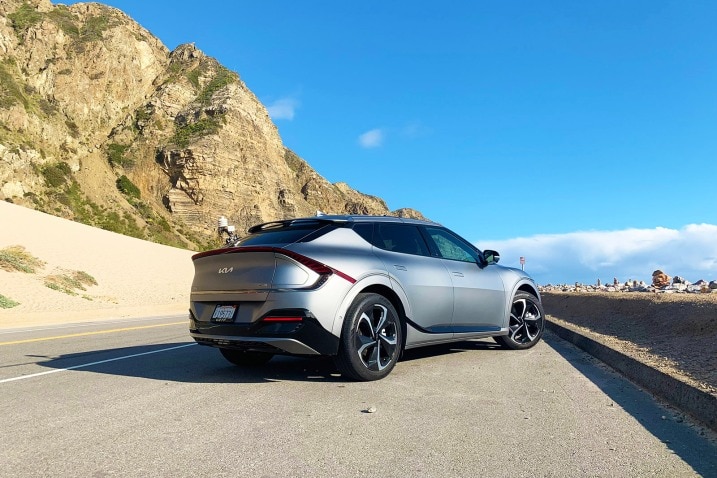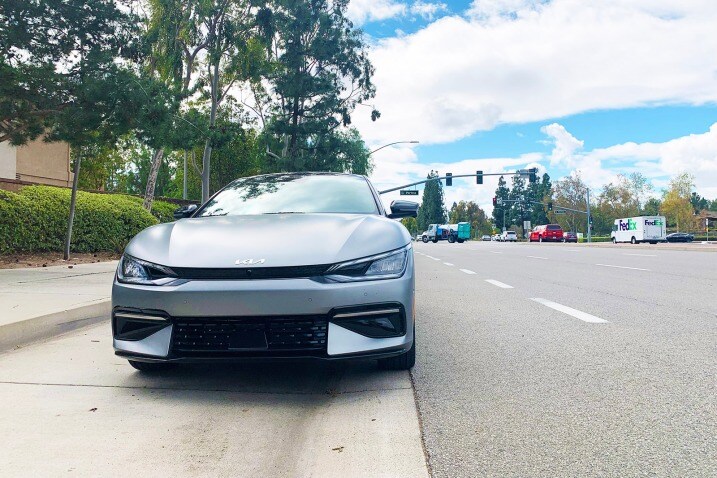- The EV6 shares its powertrain hardware and batteries with Hyundai's Ioniq 5 but boasts a range of 274 miles to the Hyundai's 256.
- However, the 2022 Kia EV6 only managed 261 miles in Edmunds' real-world EV range test, falling short of the EPA estimate.
- That puts it in a league with every Tesla we've tested, but only one other non-Tesla model (the Polestar 2 Performance).
TESTED: 2022 Kia EV6 Falls Short of EPA Range Estimate
The EV6 is one of just two non-Teslas to miss the mark in our real-world testing
Kia's all-new, all-electric 2022 EV6 has finally arrived, and not a moment too soon. As of this writing, gas prices are skyrocketing and shopper interest in EVs has never been higher. The EV6 is particularly interesting because it's built on a platform designed to be an EV from the start, which should give it an edge. Previously, Kia's EVs were variants of vehicles that also offered gas-burning engines.
Our EV6 GT-Line trim test car came equipped with the larger 77.4-kWh battery pack and the optional second motor. Combined, the two electric motors send a healthy 320 horsepower and 446 lb-ft of torque to all four wheels. In this configuration, the EPA rates the EV6 at 274 miles of range per full charge. How do you think it performed on our real-world EV range loop? Read on to find out.
Am I Ready for an EV?
- EV ownership works best if you can charge (240V) at home or at work This typically means a 240V home installation, but you could also have a similar setup at your office or other places your car is already parked for several hours each day. Don't expect a regular household outlet (120V) to suffice unless you've got a plug-in hybrid, in which case overnight charging at home is feasible.
- If you can’t charge at home, charging at a charging station could take at least 10x longer than at a gas station With public charging infrastructure still in its infancy, the user experience can be maddeningly inconsistent. Tesla owners tend to rave about the reliability and speed of the company's proprietary Supercharger stations, but rival DC fast options have thus far been plagued by technical issues and overcrowding. It's an evolving landscape and our best advice is to do your research on the available options for the EV you want to buy.
- Adding a 240V home charging system could cost up to $1,600 or more If your existing electrical service can handle the additional demands of EV charging, you may be able to add Level 2 charging at home for less than a grand, including installation. But your costs will multiply if you need to upgrade your electrical panel or add a dedicated circuit.
Testing the EV6 in the real world
Edmunds tests every new electric vehicle on the same real-world driving loop to see just how far it can travel from a full charge down to zero miles remaining. If you scroll through our EV range leaderboard, you'll see that most EVs have matched or exceeded their EPA range estimates in our testing. Much of that has to do with our ability to test in near-ideal conditions year-round.
Our dual-motor EV6 had 20-inch wheels with all-season tires (Continental CrossContact RX, 255/45 R20) that were inflated to the factory-recommended pressure of 36 psi, a far lower tire pressure than we're used to seeing for EVs. Rolling the EV6 onto our scales at our test track revealed it weighed 4,649 pounds, which is 49 pounds lighter than the comparably equipped Hyundai Ioniq 5 we tested just a few weeks before.
Over the course of a full day of driving at a slightly chilly average temperature of 58 degrees, we managed to travel a total of 261 miles, missing the EPA range target by 13 miles or roughly 5%. By comparison, the Ioniq 5, which had the same batteries and motors and weighed slightly more, traveled 270 miles on a slightly cooler 55-degree day, which is typically worse for range. In the grand scheme of things, 9 miles is not a big difference, but after looking over our full testing numbers, we're not too surprised that the EV6 came up short.
After testing the EV6's dynamic performance at the Edmunds test track, we found it to be strikingly similar to the Hyundai Ioniq 5. In a few cases, though, the EV6 seemed to have a slight performance advantage, particularly in braking and cornering, which likely means slightly grippier tires (they are the same size but from different manufacturers). We aren't counting out the slight weight advantage either, but at 1% of the total car's body weight, we doubt it's enough to move the needle.
Performance often comes at the price of something else, and in this case, we're guessing efficiency. So why, then, with a slight performance advantage and virtually identical powertrain hardware, would the Kia EV6 have an 18-mile range advantage over the Hyundai? By our real-world account, it doesn't.
So how much does it cost to charge up an EV6?
While the total range of a vehicle continues to dominate the EV conversation and will likely be a popular talking point for the EV6, energy consumption is an important factor as well. Energy consumption is what determines how much your miles will cost you. The unit of measurement for consumption, the kilowatt-hour, can be thought of as the EV equivalent of a gallon of gasoline. Just like gas, the price of electricity varies depending on where you live. For example, you'll pay about 9 cents per kWh in North Dakota as of this writing, whereas in Hawaii it'll run you about 36 cents.
So, what can EV6 owners expect to pay at "the pump"? After charging the battery back to full, we calculated an Edmunds consumption rate of 32.4 kWh/100 miles, which is 1.3% less efficient than the EPA estimate of 32 kWh/100 miles. If we lived in Hawaii, our 261-mile trip in the EV6 would have cost us $30.44, while if we lived in North Dakota, that same trip would cost just $7.61.
If we compare the EV6 to its most efficient competition, the Tesla Model Y Long Range (26.2 kWh/100 miles), the same 261 miles would have cost $24.62 in Hawaii and $6.15 in North Dakota. In other words, the differences in your fuel bill will be marginal if you're choosing between the EV6 and any of its close competitors. So you can rest easy even if you live in a state where you pay a premium for electrons.
How about a gasoline-powered equivalent? We used the Audi SQ5 as an example for the Ioniq 5, so given their similarities, we decided to use it for the Kia too. The SQ5's turbocharged 3.0-liter V6 requires premium fuel and is estimated to return an unimpressive 20 mpg in combined driving. Driving it for 261 miles would have set us back $71.51 in Hawaii ($5.48 per gallon) and $57.03 in North Dakota ($4.37 per gallon) at current prices, assuming we got the SQ5's combined mpg.
Based on these numbers, you could save an estimated $1,574 per year in Hawaii and $1,893 per year in North Dakota by driving an EV6 for 10,000 miles instead of an SQ5. The Kia arguably isn't quite as nice to look at as the SQ5 and it's not as luxurious on the inside, but we see no real advantages to picking the Audi in terms of driving enjoyment or cost.
For more information on how we test EV range and how each vehicle performed, we invite you to visit our Real World vs. EPA testing page, which includes both our EV range leaderboard and a table with detailed test results. Our EV range leaderboard is embeddable and will automatically update every time we add a new vehicle.
Edmunds says
Given our conservative testing methodology and near-ideal test conditions, it's surprising and notable that the 2022 Kia EV6 failed to match its EPA estimate in our hands. We doubt that anyone will see the type of range that is being advertised for this car. Nonetheless, the Kia EV6 remains a strong choice if you're shopping for an EV since 261 miles is nothing to sneeze at — the Tesla Model Y Performance managed 263 miles in our test — and we thoroughly enjoyed many other aspects of the driving experience. Some of us think it looks pretty cool, too. For our latest comprehensive ratings of all electric vehicles, head over to Edmunds' EV rankings page.








 by
by